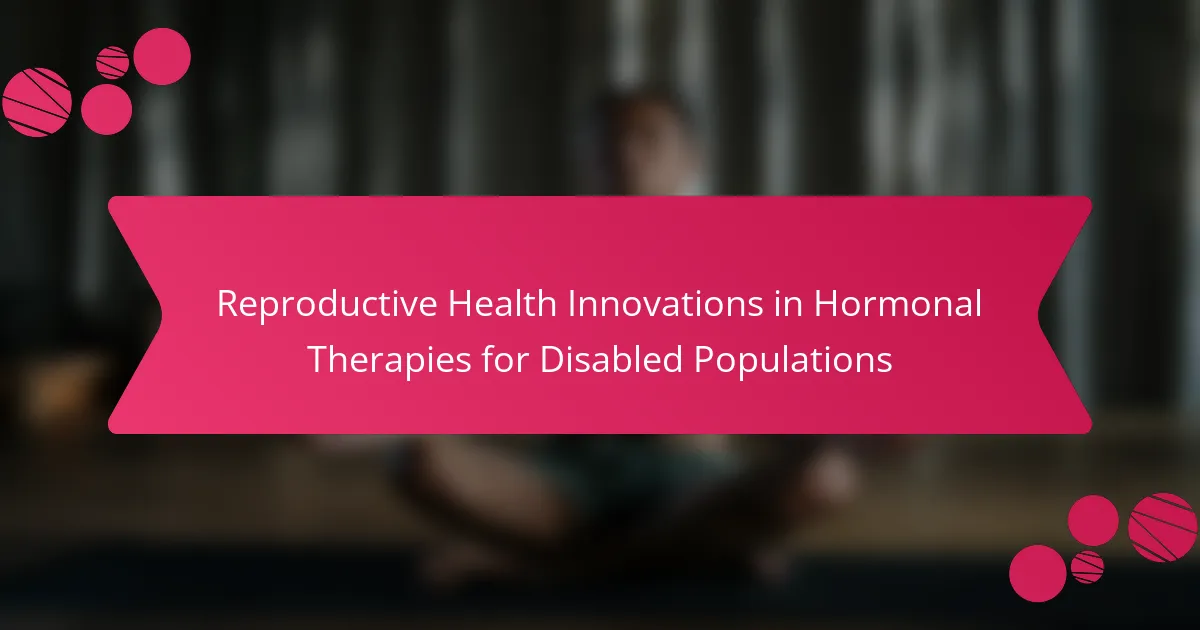Innovations in hormonal therapies are transforming reproductive health for disabled populations. Key advancements include personalized treatment plans, improved delivery methods, and enhanced side effect management. Accessibility challenges, such as financial constraints and inadequate infrastructure, hinder effective treatment. Tailored approaches consider individual needs, ensuring better health outcomes and quality of life for those with disabilities.
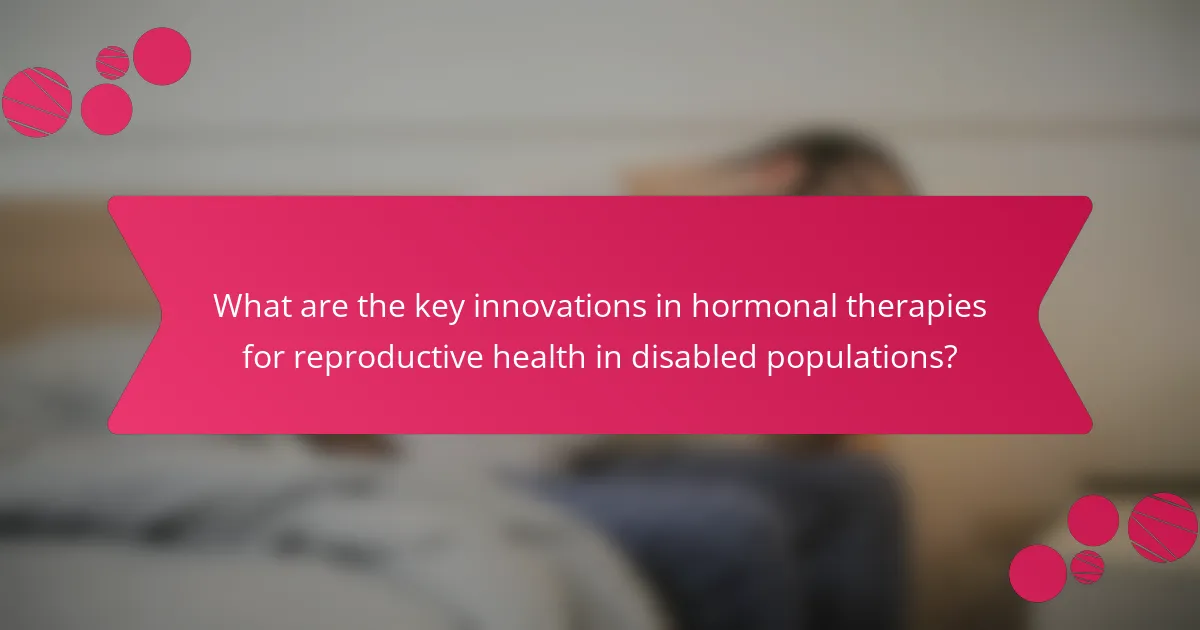
What are the key innovations in hormonal therapies for reproductive health in disabled populations?
Key innovations in hormonal therapies for reproductive health in disabled populations include personalized treatment plans, improved delivery methods, and enhanced side effect management. Personalized approaches consider individual needs and conditions, optimizing hormone levels effectively. Advanced delivery methods, such as transdermal patches and implantable devices, provide consistent hormone release and ease of use. Enhanced management strategies focus on minimizing adverse effects, improving overall patient quality of life. These innovations ensure better reproductive health outcomes and accessibility for disabled individuals.
How are these innovations addressing specific reproductive health needs?
Reproductive health innovations in hormonal therapies specifically address the unique needs of disabled populations by enhancing accessibility and efficacy. Tailored hormonal treatments consider diverse physical and cognitive challenges, ensuring better management of reproductive health issues. For instance, transdermal patches and injections simplify administration for individuals with mobility limitations. Additionally, personalized dosing regimens accommodate varying metabolic rates and health conditions, promoting optimal therapeutic outcomes. These innovations empower disabled individuals to engage more fully in their reproductive health decisions, ultimately improving quality of life.
Which organizations are leading the development of these therapies?
Leading organizations in the development of hormonal therapies for disabled populations include the World Health Organization, the National Institutes of Health, and various academic institutions. These entities focus on innovative approaches to enhance reproductive health access and outcomes. Collaborative efforts between non-profits and research organizations are also vital in advancing these therapies.

What challenges do disabled individuals face in accessing hormonal therapies?
Disabled individuals face significant barriers in accessing hormonal therapies, including physical, financial, and informational challenges. Accessibility issues arise from inadequate infrastructure, such as lack of transportation and facilities. Financial constraints often limit access to necessary treatments due to high costs and insufficient insurance coverage. Additionally, gaps in healthcare provider knowledge about the unique needs of disabled populations can lead to misinformation and inadequate care options. These factors collectively hinder the ability of disabled individuals to receive timely and appropriate hormonal therapies.
How do cultural perceptions impact the accessibility of these treatments?
Cultural perceptions significantly influence the accessibility of hormonal therapies for disabled populations. Stigmas surrounding disability can lead to inadequate healthcare support and limited awareness of available treatments. Societal attitudes often dictate whether these innovations are embraced or rejected, impacting funding and research initiatives. Furthermore, cultural beliefs may affect the willingness of healthcare providers to recommend hormonal therapies, creating barriers to access. Addressing these perceptions is crucial for improving treatment availability and ensuring equitable healthcare for all individuals.
What role do healthcare providers play in facilitating access?
Healthcare providers play a crucial role in facilitating access to hormonal therapies for disabled populations. They ensure personalized care, advocate for patient needs, and navigate healthcare systems effectively. Providers educate patients about available reproductive health innovations and address specific barriers faced by disabled individuals. By fostering inclusive environments, they enhance access to necessary treatments and support.
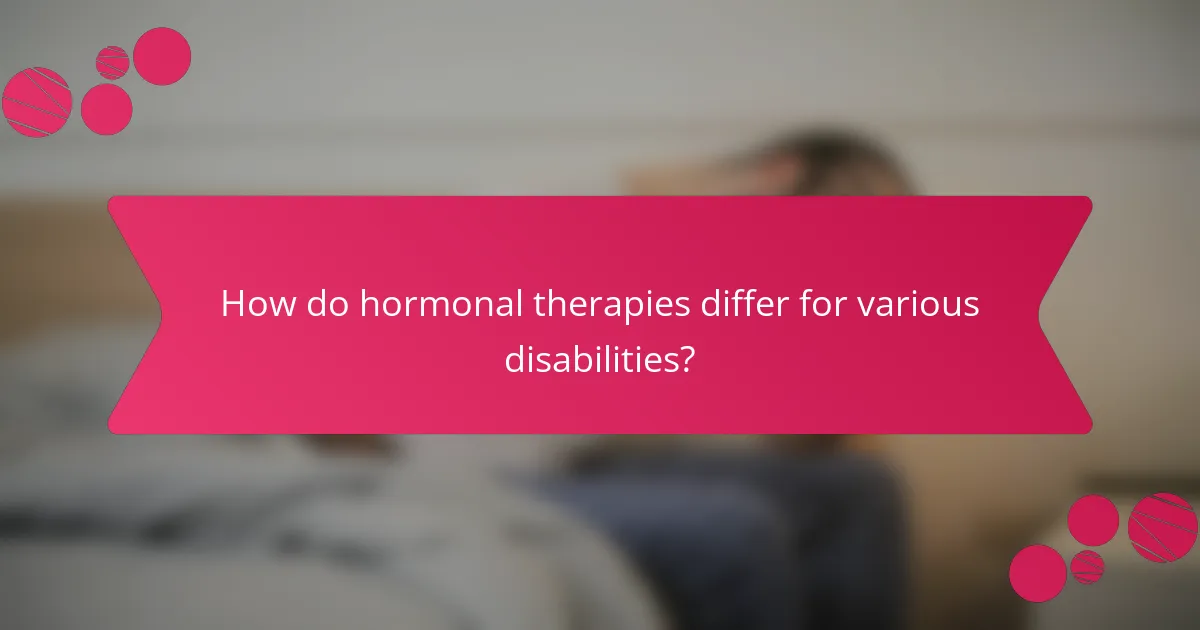
How do hormonal therapies differ for various disabilities?
Hormonal therapies vary for disabled populations based on specific needs and health conditions. These therapies can be tailored to address unique reproductive health challenges faced by individuals with disabilities. For instance, hormonal treatments may differ in administration routes, dosages, and side effect management.
Individuals with mobility impairments may benefit from transdermal patches or injections, while those with cognitive disabilities might require simplified regimens. Research indicates that personalized approaches improve efficacy and adherence to treatment.
Additionally, accessibility plays a crucial role in the implementation of hormonal therapies. Healthcare providers must consider the physical and communication barriers that disabled individuals may encounter. This ensures that all patients receive appropriate and effective hormonal interventions.
Overall, the differentiation in hormonal therapies for disabled populations is essential for enhancing reproductive health outcomes. Tailoring these treatments considers the unique attributes of each individual’s condition and lifestyle.
What unique considerations are there for individuals with physical disabilities?
Individuals with physical disabilities face unique considerations in accessing reproductive health innovations in hormonal therapies. Accessibility to treatment options, tailored communication strategies, and the need for inclusive healthcare environments are essential. Additionally, the effectiveness of hormonal therapies may vary based on individual physical conditions, necessitating personalized approaches. Addressing these factors ensures equitable reproductive health care for disabled populations.
How do cognitive disabilities influence treatment options?
Cognitive disabilities significantly shape treatment options for hormonal therapies in disabled populations. Individualized approaches consider specific needs and capabilities, ensuring effective management of reproductive health. Tailored therapies may include alternative delivery methods, dosage adjustments, and comprehensive support systems. These adaptations enhance accessibility and efficacy, ultimately improving health outcomes for individuals with cognitive disabilities.
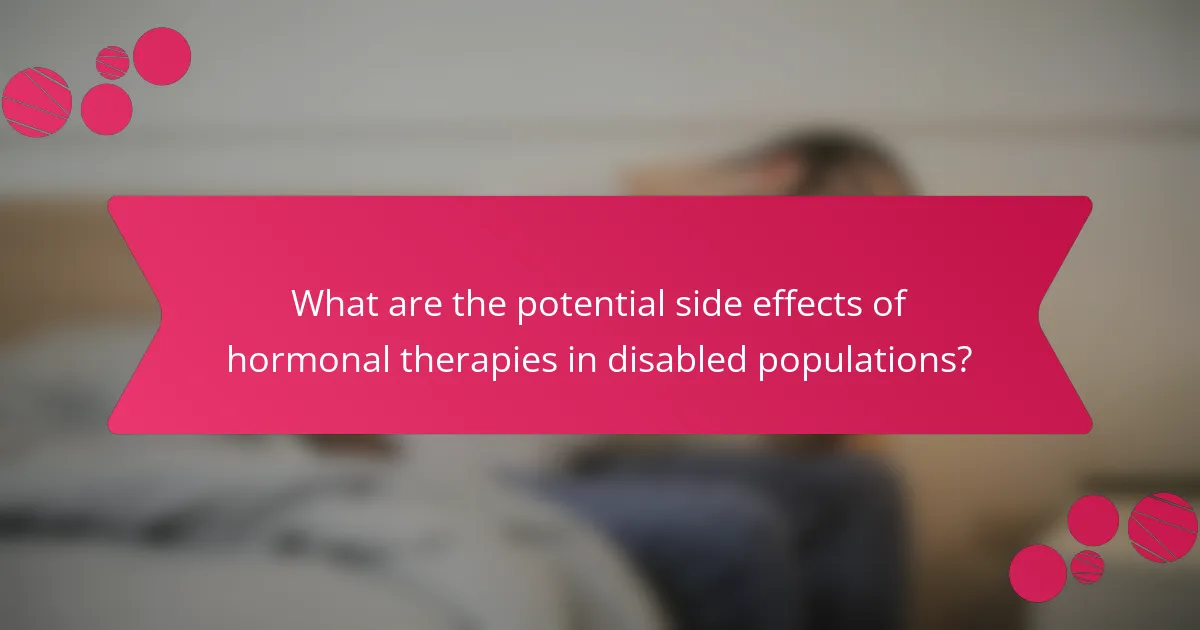
What are the potential side effects of hormonal therapies in disabled populations?
Hormonal therapies can lead to various side effects in disabled populations, including mood changes, weight gain, and metabolic alterations. These effects may vary based on individual health conditions and the specific type of therapy used. For example, some individuals may experience increased risk of blood clots or cardiovascular issues. Monitoring and personalized treatment plans are essential to mitigate these risks.
How can these side effects be managed effectively?
Managing side effects of hormonal therapies for disabled populations involves personalized strategies and supportive care. Regular monitoring of symptoms allows for timely adjustments in therapy. Incorporating lifestyle modifications, such as diet and exercise, can mitigate some side effects. Collaboration with healthcare providers ensures tailored interventions, enhancing overall reproductive health. Utilizing patient education resources empowers individuals to understand and manage their experiences effectively.
What support systems are available for monitoring side effects?
Support systems for monitoring side effects in hormonal therapies include healthcare providers, telehealth services, and patient support groups. Healthcare providers offer personalized assessments and adjustments to therapy based on side effects. Telehealth services enable remote consultations, ensuring continuous monitoring. Patient support groups provide community and shared experiences, fostering emotional support and information exchange. These systems enhance the overall management of reproductive health for disabled populations.

Which advancements in technology are enhancing hormonal therapy delivery?
Advancements in technology enhancing hormonal therapy delivery include telemedicine, wearable devices, and personalized treatment algorithms. Telemedicine provides remote consultations, improving access for disabled populations. Wearable devices monitor hormone levels in real-time, allowing for timely adjustments. Personalized algorithms analyze individual responses, optimizing treatment effectiveness. These innovations ensure more tailored and accessible hormonal therapies.
How are telehealth services changing the landscape of hormonal therapies?
Telehealth services are revolutionizing hormonal therapies for disabled populations by enhancing accessibility and personalization. Remote consultations enable patients to receive tailored treatments without the barriers of travel or physical limitations. This approach allows for continuous monitoring and adjustments based on real-time feedback, improving overall treatment efficacy. Additionally, telehealth platforms often provide educational resources that empower patients to better understand their hormonal health, fostering informed decision-making. As a result, the integration of telehealth in hormonal therapies is breaking down traditional barriers, leading to more inclusive reproductive health care.
What role do wearable devices play in monitoring hormonal health?
Wearable devices significantly enhance monitoring of hormonal health by providing real-time data on physiological changes. These devices track metrics such as heart rate variability, sleep patterns, and body temperature, which correlate with hormonal fluctuations. For disabled populations, this technology offers accessible insights, facilitating personalized hormonal therapies. Additionally, wearables can alert users to irregularities, promoting proactive health management. The integration of these devices into reproductive health innovations supports improved outcomes and tailored interventions.
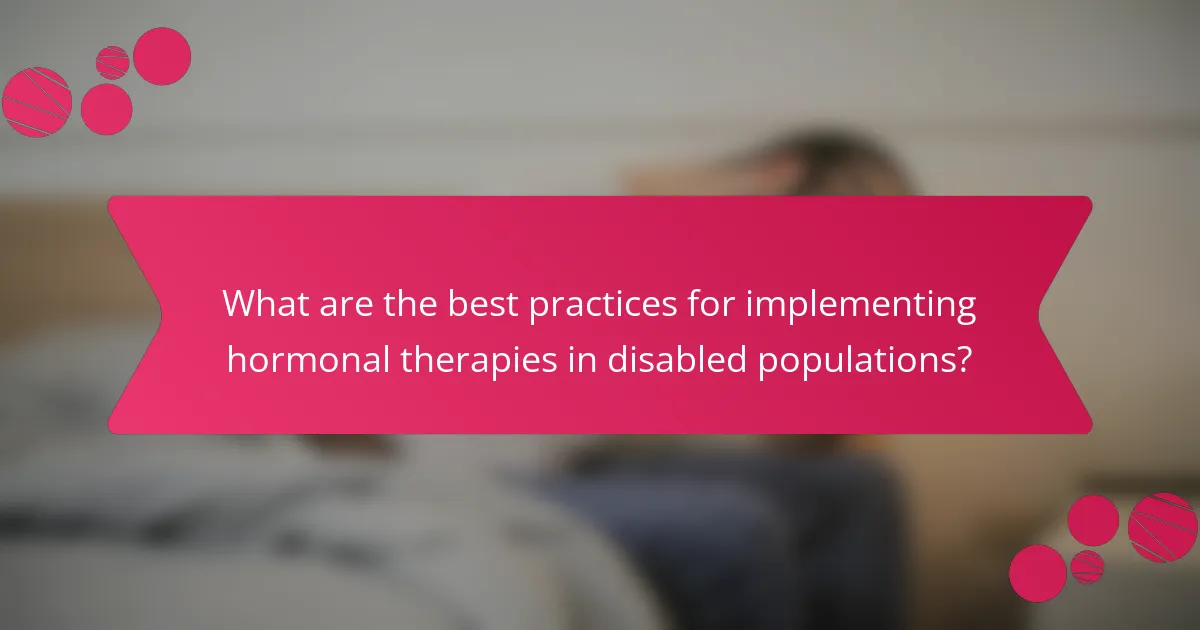
What are the best practices for implementing hormonal therapies in disabled populations?
Implementing hormonal therapies in disabled populations requires careful consideration of individual needs and accessibility. Best practices include personalized treatment plans, thorough patient education, and continuous monitoring of outcomes.
1. Assess individual health conditions and limitations to tailor therapies effectively.
2. Ensure accessible communication about treatment options and potential side effects.
3. Collaborate with multidisciplinary teams to address diverse health needs.
4. Monitor and adjust therapies based on patient feedback and health changes.
What strategies can healthcare providers use to improve patient adherence?
Healthcare providers can enhance patient adherence by implementing personalized communication strategies. Tailoring messages to individual needs fosters a stronger connection. Utilizing technology, such as mobile health applications, allows for reminders and tracking. Additionally, involving patients in decision-making empowers them, increasing their commitment to treatment plans. Education about hormonal therapies’ benefits is crucial, particularly for disabled populations, to improve understanding and adherence.
How can patient education be tailored to meet diverse needs?
Patient education can be tailored by incorporating diverse communication methods and individualized support. Utilizing visual aids and technology enhances understanding for disabled populations. Personalized education plans consider unique needs, ensuring accessibility and engagement. Regular feedback loops allow for adjustments based on patient responses, fostering better outcomes in reproductive health innovations.
What common mistakes should be avoided when prescribing hormonal therapies?
Common mistakes to avoid when prescribing hormonal therapies include neglecting individual patient needs, overlooking potential drug interactions, and failing to monitor side effects. Ensuring informed consent and understanding unique attributes of hormonal therapies is crucial. Additionally, not considering the specific reproductive health challenges faced by disabled populations can lead to ineffective treatment plans. Regular follow-ups are essential to adjust therapies based on patient responses.
